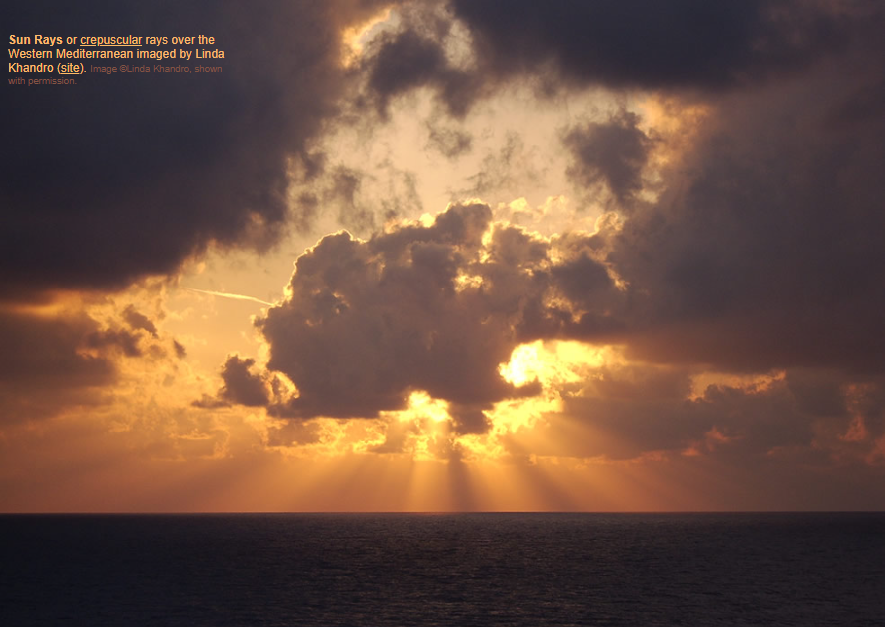Mediterranean Rays
Mediterranean Rays: A Phenomenon of Light in the Western Mediterranean
When gazing at the sky during a beautiful sunset or sunrise over the Western Mediterranean, you may have noticed a captivating optical phenomenon known as "Mediterranean Rays." These ethereal rays, also called crepuscular rays, create a mesmerizing display of light that captures the imagination. In this article, we will explore the science behind Mediterranean Rays and delve into the factors that contribute to their formation.
The Science Behind Mediterranean Rays
Mediterranean Rays are a type of atmospheric optical phenomenon that occurs when sunlight is scattered or blocked by objects such as clouds, mountains, or buildings. The rays appear as beams of light that radiate from a central point, creating a fan-like pattern in the sky. Although they appear tangible, these rays are not physical objects but rather an optical illusion caused by the scattering of sunlight.
Formation Factors
Several factors contribute to the formation of Mediterranean Rays. Let's take a closer look at each one:
-
Sun Position: The position of the sun in relation to the observer plays a crucial role in the appearance of crepuscular rays. When the sun is low on the horizon during sunrise or sunset, its rays have to pass through a greater portion of Earth's atmosphere. This atmospheric passage causes the rays to scatter and create the distinctive pattern seen in Mediterranean Rays.
-
Obstacles: Objects such as clouds, mountains, or buildings can obstruct the path of sunlight, creating areas of shadow and allowing the rays to become visible. As sunlight interacts with these obstacles, it scatters and illuminates the surrounding air, making the rays more pronounced.
-
Atmospheric Conditions: The presence of particles and moisture in the atmosphere also influences the formation of Mediterranean Rays. Dust, water droplets, and other airborne particles can scatter sunlight, enhancing the visibility of the rays. Additionally, variations in temperature and humidity can affect the density and distribution of these particles, further enhancing the phenomenon.
Types of Mediterranean Rays
Mediterranean Rays can manifest in different forms, each with its own unique characteristics. Here are some notable variations:
-
Crepuscular Rays: These are the most common type of Mediterranean Rays, appearing as rays of light that extend from the horizon towards the observer. They often resemble the spokes of a wheel or the beams of a spotlight.
-
Anticrepuscular Rays: Unlike crepuscular rays that radiate from the sun, anticrepuscular rays appear to converge at a point opposite the sun. This phenomenon occurs when the observer's shadow is cast directly opposite the sun, creating an illusion of rays converging towards a vanishing point.
-
Brocken Spectre: A rare and captivating sight, the Brocken Spectre occurs when an observer's shadow is cast onto a cloud or fog bank. This creates a halo-like effect around the shadow, accompanied by a glory, which is a series of concentric rings of colored light.
Cultural Significance
Mediterranean Rays have captivated human imagination throughout history and have been interpreted in various cultural contexts. In ancient times, these rays were often associated with divine or supernatural entities. They were seen as messages from the gods or as celestial pathways connecting heaven and earth. Even today, Mediterranean Rays continue to inspire awe and wonder, serving as a reminder of the beauty and complexity of our natural world.
Capturing the Beauty
Photographers and artists are drawn to the enchanting beauty of Mediterranean Rays, often attempting to capture their essence in their work. The interplay between light and shadow, the ethereal quality of the rays, and the dramatic backdrop of the Western Mediterranean create breathtaking imagery that evokes a sense of tranquility and wonder.
Conclusion
Mediterranean Rays, or crepuscular rays, are a captivating atmospheric optics phenomenon that graces the Western Mediterranean with its awe-inspiring display of light. Understanding the science behind their formation, the factors that contribute to their appearance, and the various types they can take allows us to appreciate their beauty on a deeper level. So, next time you find yourself gazing at a stunning sunset or sunrise over the Western Mediterranean, take a moment to immerse yourself in the splendor of Mediterranean Rays and marvel at the wonders of our natural world.

Sun Rays or crepuscular rays over the Western Mediterranean imaged by Linda Khandro (site). Image ©Linda Khandro, shown with permission.
Note: this article has been automatically converted from the old site and may not appear as intended. You can find the original article here.
Reference Atmospheric Optics
If you use any of the definitions, information, or data presented on Atmospheric Optics, please copy the link or reference below to properly credit us as the reference source. Thank you!
-
<a href="https://atoptics.co.uk/blog/mediterranean-rays/">Mediterranean Rays</a>
-
"Mediterranean Rays". Atmospheric Optics. Accessed on April 20, 2024. https://atoptics.co.uk/blog/mediterranean-rays/.
-
"Mediterranean Rays". Atmospheric Optics, https://atoptics.co.uk/blog/mediterranean-rays/. Accessed 20 April, 2024
-
Mediterranean Rays. Atmospheric Optics. Retrieved from https://atoptics.co.uk/blog/mediterranean-rays/.